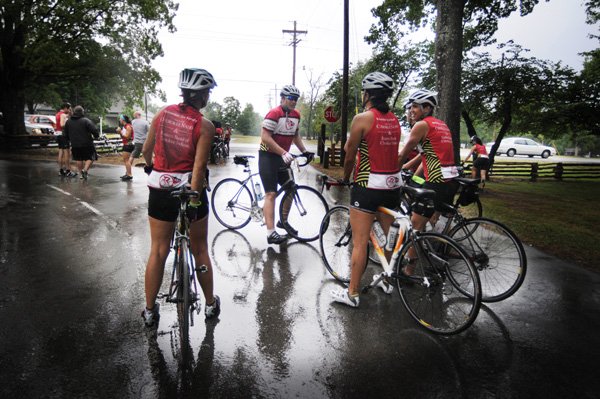PRAIRIE GROVE — A unexpected downpour Thursday morning slowed, but didn’t stop, progress of 22 Cherokee cyclists retracing the path of their ancestors along the Trail of Tears.
The cyclists traveled through Northwest Arkansas on Wednesday and Thursday on their way to a homecoming celebration today in Tahlequah, Okla., capitol of the Cherokee Nation.
The bike riders came from the 15 Oklahoma counties that make up the Cherokee Nation. Seven were from the Eastern Band of the Cherokee Indians in North Carolina.
At A Glance
The Trail of Tears
The U.S. government signed a treaty with a minority faction of the Cherokee Nation willing to cede the remaining portion of Cherokee homeland in 1835. Despite protests of most Cherokee people, the fraudulent Treaty of New Echota was ratified by the U.S. Senate by a single vote on May 23, 1836. The Cherokees were given two years to move to the Indian Territory. Nearly all 17,000 Cherokees were forced to move. Under orders from President Andrew Jackson, the U.S. Army began enforcement of the Removal Act, rounding up Cherokees in the summer of 1838. An estimated 4,000 died from hunger, exposure and disease. The journey became a cultural memory as the “trail where they cried” for the Cherokees and other removed tribes.
Source: Cherokee National website, www.cherokee.org/.
“For us coming from North Carolina, we’re getting more of the experience, the true experience, of what it was to leave their homeland,” said Chi Shipman, 29. The 1,000-mile, seven-state journey was her first to Oklahoma. She is from Fletcher and Cherokee, N.C.
The cyclists stopped Thursday at the Latta House and Barn at Prairie Grove Battlefield National Park for a break.
The group began riding June 4 from New Echota, Ga., the capitol of the Cherokee Nation before the tribe was uprooted from their lands in the southeastern U.S. to what as then Indian Territory, now Oklahoma, in the late 1830s. New Echota is considered a starting point for the removal known as the Trail of Tears.
The annual “Remember the Removal” bike rides began in 2009 as a way for participants to learn about their history. The first ride was in 1984, but it was restarted on that ride’s 25th anniversary in 2009. It’s paid for by the Cherokee Nation.
Riders traveled through Georgia, Tennessee, Kentucky, Illinois, Missouri, Arkansas and Oklahoma.
Jerrad Dry, 23, of Tahlequah made his third trip as part of the cycling group.
“I learn new things every time,” Dry said Thursday morning, rain dripping down his face. “It’s a whole different story when you think of the mindset of our ancestors in 1839.”
The group has traveled between 50 and 60 miles a day on the northern route the Cherokees followed to leave Georgia and travel to Oklahoma.
Dry said there were several routes the various tribes traveled to reach Indian Territory.
“The northern route is the most common,” he said.
Shipman said what she learns on the route will help her introduce Cherokee heritage to her 3-year-old daughter.
“I wanted to learn more about my ancestors,” Shipman said.
One of the most impressive stops for her was Mantel Rock in western Kentucky near the Ohio River. It’s a place where some 1,000 Cherokee stayed during a grueling winter before crossing the Ohio River into the southern tip of Illinois.
“It was the dead of winter and there was an issue getting across the Ohio River,” she said.
LeeAnn Dreadfulwater, communications manager for the Cherokee Nation, said some of the cyclists found family roots on the trip. One rider found she was related to seven other riders after a genealogist helped trace their family histories, Dreadfulwater said.
The group, including Dreadfulwater, an emergency management technician and a marshal from the Cherokee Nation, and four support vehicles planned to spend the night in Stilwell, Okla., before concluding the ride in Tahlequah today.
“We camped the first day in the rain and we are ending it with rain,” Dreadfulwater said.

